|
From this point on, things will
move quickly – a proposed merger of Barclays, Lloyds and Martins Banks,
whilst thoroughly researched and feasible, is turned down by the Monopolies
Commission, who prefer a merger on a smaller scale. Eight months after announcing
its decision to seek a buyer, Martins reaches the first important date in its
irrevocable marriage to Barclays, 1 November 1968. This leaves just thirteen
months in which both Banks will have to compare Branches and services, so
that the best of each can be retained for the combined business. There is
also the task of informing the customers of both Banks not only about the
merger itself, but also of the perceived benefits…

Are you sitting comfortably? Then we’ll begin…


 An eagle, out for a walk, came
to a pleasant stream. Beside it stood a grasshopper, plump and chirpy.
‘Glorious day,’ said the grasshopper, vaulting behind a stone. ‘Indeed,’
replied the eagle. ‘Delightful part of the world, this,’ said the
grasshopper. ‘Must confess I don’t know it all that well,’ replied the eagle.
‘Not half as well as you do. Dashed clever, you grasshoppers. Ear close to
the ground, I suppose?’ ‘Oh, very,’ said the grasshopper, looking out
warily. ‘Perhaps we ought to get together—some sort of
amalgamation. Why, with my local knowledge and your fine feathers . .
.’ ‘That’s a thought,’ said the eagle.
Taking a step forward. ‘But not any sort of amalgamation, said the grasshopper, I’ve
noticed worms becoming amalgamated with starlings every morning at breakfast
time.’ ‘Fiddlesticks,’ said the eagle, ‘do you take me for a fool? What could
I gain by gobbling you up ?’ ‘Well’—the grasshopper
sounded
piqued—'I dare say I’m very tasty.’ ‘Piffle! ‘Said the eagle.
‘Look, if I ate you, you’d be gone, wouldn’t you ‘ ‘That’s very true.’ - ‘But
if we amalgamated, you could tell me all about this enchanting stream you
know so well.’ The grasshopper was half-way out of hiding now. ‘And I could give you lifts to all sorts of
places—I travel a lot, you know,’
continued the eagle.
‘Would you take me soaring?’ ‘Frequently.’ ‘And introduce me to some of your
large friends?’ ‘That would be my pleasure.’ They both stood thinking for a
long time. ‘And I could teach you to jump!’ said the grasshopper with sudden
cheerfulness. ‘A thing I’ve never really mastered,’ said
the eagle.
‘And I have a trick way of rubbing my legs together. Listen . . .’ ‘I doubt
if I’ll ever manage that,’ said the eagle, ‘but I’d love to try.’ And off they went together, ironing out the
formalities. And so it was that Barclays and Martins decided to join forces. An eagle, out for a walk, came
to a pleasant stream. Beside it stood a grasshopper, plump and chirpy.
‘Glorious day,’ said the grasshopper, vaulting behind a stone. ‘Indeed,’
replied the eagle. ‘Delightful part of the world, this,’ said the
grasshopper. ‘Must confess I don’t know it all that well,’ replied the eagle.
‘Not half as well as you do. Dashed clever, you grasshoppers. Ear close to
the ground, I suppose?’ ‘Oh, very,’ said the grasshopper, looking out
warily. ‘Perhaps we ought to get together—some sort of
amalgamation. Why, with my local knowledge and your fine feathers . .
.’ ‘That’s a thought,’ said the eagle.
Taking a step forward. ‘But not any sort of amalgamation, said the grasshopper, I’ve
noticed worms becoming amalgamated with starlings every morning at breakfast
time.’ ‘Fiddlesticks,’ said the eagle, ‘do you take me for a fool? What could
I gain by gobbling you up ?’ ‘Well’—the grasshopper
sounded
piqued—'I dare say I’m very tasty.’ ‘Piffle! ‘Said the eagle.
‘Look, if I ate you, you’d be gone, wouldn’t you ‘ ‘That’s very true.’ - ‘But
if we amalgamated, you could tell me all about this enchanting stream you
know so well.’ The grasshopper was half-way out of hiding now. ‘And I could give you lifts to all sorts of
places—I travel a lot, you know,’
continued the eagle.
‘Would you take me soaring?’ ‘Frequently.’ ‘And introduce me to some of your
large friends?’ ‘That would be my pleasure.’ They both stood thinking for a
long time. ‘And I could teach you to jump!’ said the grasshopper with sudden
cheerfulness. ‘A thing I’ve never really mastered,’ said
the eagle.
‘And I have a trick way of rubbing my legs together. Listen . . .’ ‘I doubt
if I’ll ever manage that,’ said the eagle, ‘but I’d love to try.’ And off they went together, ironing out the
formalities. And so it was that Barclays and Martins decided to join forces.
Moral: Marriage is to politics what the lever is to engineering.
The
state is not founded upon single individuals
But
upon couples and groups.
Novalis

Text and Images ©
Barclays 1968

Special Note from the Editor

  Whilst singing
the praises of Martins Bank and looking back with fondness upon its life,
times, and achievements, it is not our place either to over-praise or to
judge history harshly. The
advertisement here (left) is published at the end of 1968, and is designed to
show customers of both Martins and Barclays, that there is much to be gained
from, and nothing to fear from “a merger”, or indeed “an amalgamation”.
Whilst compiling this part of the online archive, it has been impossible for
me to ignore the feelings of a large number of Martins staff who, even in
2009 when we launched, were still feeling betrayed over the 1969 merger. Whilst singing
the praises of Martins Bank and looking back with fondness upon its life,
times, and achievements, it is not our place either to over-praise or to
judge history harshly. The
advertisement here (left) is published at the end of 1968, and is designed to
show customers of both Martins and Barclays, that there is much to be gained
from, and nothing to fear from “a merger”, or indeed “an amalgamation”.
Whilst compiling this part of the online archive, it has been impossible for
me to ignore the feelings of a large number of Martins staff who, even in
2009 when we launched, were still feeling betrayed over the 1969 merger.
To many, a fundamental promise –
that the name of Martins Bank will live on – is broken even before the
act of Parliament that brings about the new Bank. The token gesture “Martins
Branch” which appears on some Barclays stationery until the early 1980s is
also not enough to calm the genuine anger and hurt. As an observer who never
worked for Martins, and given that time is usually such a great healer, I am
genuinely shocked and saddened by the comments we regularly receive on this
matter, and I completely understand and sympathise with those who thought one
thing, but witnessed another.
With a brand as successful as Barclays, there is
never any real doubt that the name of Martins will have to disappear, and the campaign to wipe Martins from the
memory is, in its own way, as sophisticated as any seen today when major
companies are brought together. Thanks however to the “Martins Branch” logo,
the changes do at least take until 1982 to fully complete, and the legacy of
Martins’ own “Branch Accounting” computer program remains with Barclays until
at least 2005. The articles in this section look at the various parts of the
process of subtle change that go into what Barclays refers to as “The end of
the beginning”, but which many, from the outset, see as the exact opposite…
Jonathan, May 2013
1967/8 – A Merger is announced…

 After one too
many late nights, it is time for the activities of that teenage upstart,
Martins Bank to be reigned in by a somewhat nervous Bank of England. The cost
of servicing the accounts of a number of the UK’s largest companies, whilst
still bent on a lavish expansion southwards is finally going to put paid to
the dreams of the Liver Bird and the Grasshopper, a divorce takes place (the
removal of the Liver Bird and any further mention of Liverpool) and a shotgun
marriage is proposed that is eagerly entered into by Barclays. The prize?
Well, it goes without saying. Barclays will gain huge representation in the
North of England, with hundreds of branches, many of them new or refurbished,
and for the bank that is in the main an amalgamation of a large number of Southern
banks, this opportunity is too good to miss. The cake comes with extra icing
in the form of a network of branches on the Isle of Man, and in the Channel
Islands, and the recently acquired Unicorn Securities, which on its own will
help Barclays pay the bills for decades to come. The liver bird has laid a
golden egg, and Barclays is first in line with a plate of bread soldiers and
a spoon. Dip in! The
beginning of the end starts innocently enough with MERGER NEWS, a publication
in which Martins naïvely seeks to reassure its staff on the aspects of what
is, to all intents and purposes, a full blown takeover of their employer.
Looking now at some of the articles printed in “Merger News”, it is sad to
note the optimism and naïvity with which questions such as “what will happen
to the Martins name”, are asked. This is one of the last publications to be
produced by Martins Bank’s own Information Department. After one too
many late nights, it is time for the activities of that teenage upstart,
Martins Bank to be reigned in by a somewhat nervous Bank of England. The cost
of servicing the accounts of a number of the UK’s largest companies, whilst
still bent on a lavish expansion southwards is finally going to put paid to
the dreams of the Liver Bird and the Grasshopper, a divorce takes place (the
removal of the Liver Bird and any further mention of Liverpool) and a shotgun
marriage is proposed that is eagerly entered into by Barclays. The prize?
Well, it goes without saying. Barclays will gain huge representation in the
North of England, with hundreds of branches, many of them new or refurbished,
and for the bank that is in the main an amalgamation of a large number of Southern
banks, this opportunity is too good to miss. The cake comes with extra icing
in the form of a network of branches on the Isle of Man, and in the Channel
Islands, and the recently acquired Unicorn Securities, which on its own will
help Barclays pay the bills for decades to come. The liver bird has laid a
golden egg, and Barclays is first in line with a plate of bread soldiers and
a spoon. Dip in! The
beginning of the end starts innocently enough with MERGER NEWS, a publication
in which Martins naïvely seeks to reassure its staff on the aspects of what
is, to all intents and purposes, a full blown takeover of their employer.
Looking now at some of the articles printed in “Merger News”, it is sad to
note the optimism and naïvity with which questions such as “what will happen
to the Martins name”, are asked. This is one of the last publications to be
produced by Martins Bank’s own Information Department.




 Martins’ petition to
the High Court to allow changes in the structure of its capital by means of
the Scheme of Arrangement was approved in the Chancery Court on Monday,
October 28.
As a result Martins will now be able to cancel its
existing shares, at the same time creating a similar amount of capital out of
the reserves arising from the cancellation. The new capital will then be
issued to Barclays Bank. Martins will close
the register for its old shares on October 31. On November 1, the operative date for the merger by the Scheme of
Arrangement, Martins’ solicitors in London will file the Court Order at the
Companies Registry. On the same day Martins’ Board will meet to approve the
creation of the new capital from the bank’s reserves, and the allotting of
those shares to Barclays. Because of the
legal requirements calling for no less than seven shareholders to appear in
the registers, the new shares will be split and placed in the name of
Barclays Bank and other nominated holders. Simultaneously,
a meeting of Barclays’ Board will create the Ordinary Stock and Loan Stock
that will be allotted to former Martins shareholders. Martins’ petition to
the High Court to allow changes in the structure of its capital by means of
the Scheme of Arrangement was approved in the Chancery Court on Monday,
October 28.
As a result Martins will now be able to cancel its
existing shares, at the same time creating a similar amount of capital out of
the reserves arising from the cancellation. The new capital will then be
issued to Barclays Bank. Martins will close
the register for its old shares on October 31. On November 1, the operative date for the merger by the Scheme of
Arrangement, Martins’ solicitors in London will file the Court Order at the
Companies Registry. On the same day Martins’ Board will meet to approve the
creation of the new capital from the bank’s reserves, and the allotting of
those shares to Barclays. Because of the
legal requirements calling for no less than seven shareholders to appear in
the registers, the new shares will be split and placed in the name of
Barclays Bank and other nominated holders. Simultaneously,
a meeting of Barclays’ Board will create the Ordinary Stock and Loan Stock
that will be allotted to former Martins shareholders.

|

Talks between the two banks about
amalgamation of their overseas business have proceeded extremely well,
says Mr. A. R. W. Wetherell, Chief Overseas Manager of Martins. Discussions
have been carried on in a cordial and co-operative atmosphere. Although it
is too early to state precisely the changes that will come about, the
prospects for working together in fields wider than Martins has known
before are ‘intriguing and exciting’, Mr. Wetherell said.
|

The two banks have formed a Coordinating
Team, whose job will be to work out a time-scale for the coordination of
the businesses. The team will work within policy lines set down by the
General Managements of the banks.
Martins’ representative in the team is
Mr. A. K. Bromley (Assistant General Manager). His colleagues from Barclays
will be Mr. R. J. H. Gillman (Secretary) who will be the team’s chairman,
and Mr. K. A. Ebbs and Mr. J. G. Quinton (Assistant General Managers)
|
|
|

 What will happen to
the name of Martins Bank under the merger ? To this question, much discussed
just now, there is so far no definite answer. Many
Martins people—staff and customers—take
the firm view that so much goodwill attaches to the name that it should
continue to appear outside our branches even though, behind the scenes,
there were administrative integration with Barclays. Others hold the equally
strong opinion that for the merger to be really effective the name of Martins
should vanish completely, and Barclays’ titling should appear above our
doors. In a recent BBC interview our Chairman, Sir Cuthbert Clegg, said
that though Martins eventually would become a completely integrated bank with
Barclays its identity would not disappear immediately. He felt sure that
Martins’ name would never be lost sight of, because of the bank’s great
history. What will happen to
the name of Martins Bank under the merger ? To this question, much discussed
just now, there is so far no definite answer. Many
Martins people—staff and customers—take
the firm view that so much goodwill attaches to the name that it should
continue to appear outside our branches even though, behind the scenes,
there were administrative integration with Barclays. Others hold the equally
strong opinion that for the merger to be really effective the name of Martins
should vanish completely, and Barclays’ titling should appear above our
doors. In a recent BBC interview our Chairman, Sir Cuthbert Clegg, said
that though Martins eventually would become a completely integrated bank with
Barclays its identity would not disappear immediately. He felt sure that
Martins’ name would never be lost sight of, because of the bank’s great
history.

|

|
Only one dissenting hand was raised
against the merger of Martins and Barclays Banks at the extraordinary
general meeting of Martins’ shareholders held at Head Office on October
10. A special meeting of shareholders, as required by the High Court, had
earlier approved the merging of the two banks by the Scheme of Arrangement.
The extraordinary meeting was needed to give effect to this Scheme.
Presiding over both meetings, the Chairman, Sir Cuthbert B. Clegg, said
that proxy votes already received gave substantial support for the merger.
|
 Sir Cuthbert was asked
to explain why Martins’ shareholders were to get Loan Stock in Barclays Bank
in part replacement of their Martins ordinary shares. The questioner was
protesting at having some of his ordinary shares changed to fixed-interest
stock. Sir Cuthbert explained that the takeover situation had inflated the
price of Martins shares: a market price of about 21 shillings would have been
more realistic. It must be appreciated that Barclays had to be fair to both
their own and Martins’ shareholders. The proportion of Barclays ordinary
shares our shareholders were to get was properly related to Martins’ assets
and the earning capacity of the capital. With the Scheme of Arrangement
approved by an overwhelming majority of Martins’ shareholders the bank had
then to seek the High Court’s approval to the Scheme. This would give effect
to the merger by early November. Sir Cuthbert was asked
to explain why Martins’ shareholders were to get Loan Stock in Barclays Bank
in part replacement of their Martins ordinary shares. The questioner was
protesting at having some of his ordinary shares changed to fixed-interest
stock. Sir Cuthbert explained that the takeover situation had inflated the
price of Martins shares: a market price of about 21 shillings would have been
more realistic. It must be appreciated that Barclays had to be fair to both
their own and Martins’ shareholders. The proportion of Barclays ordinary
shares our shareholders were to get was properly related to Martins’ assets
and the earning capacity of the capital. With the Scheme of Arrangement
approved by an overwhelming majority of Martins’ shareholders the bank had
then to seek the High Court’s approval to the Scheme. This would give effect
to the merger by early November.

  The main executive body within Barclays Bank comprises five
members of the ‘Chair’ (the Chairman, two Deputy Chairmen and two
Vice-Chairmen) and the six General Managers. They meet daily in the
Chairman’s Committee and act together as a team. Each
of the six General Managers is nominally responsible for specific aspects of
the business but all are interchangeable so that they can act for one another
during absences. In this way decisions are not delayed pending the return of
the appropriate General Manager. In addition
there are 13 Assistant General Managers, each with a special sphere of
responsibility (lending, automation, premises, staff, etc.). A number of
heads of departments have Assistant General Manager status: these include the
Chief Accountant, Chief Inspector, Investment Manager, Secretary, Staff
Managers and Principal of the Staff Training Centre. Mr. John Thomson has been Chairman of Barclays Bank since 1962. He was
educated at Winchester College and Magdalen College, Oxford, and joined Barclays’
81 Fleet Street office in 1929. After five
years at the Peterborough Local Head Office he was appointed a Local
Director at Oxford in 1935. His appointment
as a director of Barclays Bank came in 1947, Vice-Chairman in 1956 and Deputy
Chairman in 1958. The main executive body within Barclays Bank comprises five
members of the ‘Chair’ (the Chairman, two Deputy Chairmen and two
Vice-Chairmen) and the six General Managers. They meet daily in the
Chairman’s Committee and act together as a team. Each
of the six General Managers is nominally responsible for specific aspects of
the business but all are interchangeable so that they can act for one another
during absences. In this way decisions are not delayed pending the return of
the appropriate General Manager. In addition
there are 13 Assistant General Managers, each with a special sphere of
responsibility (lending, automation, premises, staff, etc.). A number of
heads of departments have Assistant General Manager status: these include the
Chief Accountant, Chief Inspector, Investment Manager, Secretary, Staff
Managers and Principal of the Staff Training Centre. Mr. John Thomson has been Chairman of Barclays Bank since 1962. He was
educated at Winchester College and Magdalen College, Oxford, and joined Barclays’
81 Fleet Street office in 1929. After five
years at the Peterborough Local Head Office he was appointed a Local
Director at Oxford in 1935. His appointment
as a director of Barclays Bank came in 1947, Vice-Chairman in 1956 and Deputy
Chairman in 1958.
 Mr. Thomson is
married and lives in Oxford. He is closely connected with many charitable
organisations and other activities in the county where he has been
Lord-Lieutenant since 1963. He has also many close ties with Oxford
University.
He was a member of the Royal Commission on Trade
Unions and Employers’ Associations. Mr. Derek Wilde is the bank’s senior
General Manager. He joined Barclays in 1929 at Sheffield, where he was
educated at King Edward VII’s school, and spent a year on the Local Head Office
staff before moving in 1938 to London and the banks’ City Trustee Department. Mr. Thomson is
married and lives in Oxford. He is closely connected with many charitable
organisations and other activities in the county where he has been
Lord-Lieutenant since 1963. He has also many close ties with Oxford
University.
He was a member of the Royal Commission on Trade
Unions and Employers’ Associations. Mr. Derek Wilde is the bank’s senior
General Manager. He joined Barclays in 1929 at Sheffield, where he was
educated at King Edward VII’s school, and spent a year on the Local Head Office
staff before moving in 1938 to London and the banks’ City Trustee Department.
He continued in the ’rustee department after war service, first
at Birmingham and then at Bournemouth, returning in 1954 to the City Trustee
Office as Manager. Two years later he became Deputy Manager of all Barclays’
Trustee Departments.
He left the Trustee side in 1957 to be Deputy Chief
Accountant from which post he became an Assistant General Manager in 1960 and
a General Manager the following year. He has been senior General Manager
since 1966. Mr. Wilde is married and lives
at Penshurst, Kent

 Barclays’ men and
women have a wide range of sporting activities available to them. In London
everyone from the newest junior to the senior manager can take advantage of
the excellently equipped Sports Club through which the Bank takes a prominent
part in all amateur sports. Individual members of Barclays’ staff have won
their places in international and Olympic events.Separate sections cover
football, rugby, hockey, cricket, netball, golf, athletics, rifle-shooting,
fencing, badminton, lawn and table tennis, chess, bridge, swimming, motoring
and judo. In addition to large sports grounds at Norbury in south London and
at Haling to the west, a fine boathouse was recently opened on the Thames at
Putney for rowing and sailing enthusiasts. In provincial centres, too, there
is provision for sport, assisted and encouraged by the management. All the
bank’s local districts compete each year in fourteen sports. A highlight of
the year is Sports Day, held at Baling in June, which takes in the inter-district athletic team championship,
the tennis finals, and a concert and dancing.
Already the possibility has been raised of Martins’ staff taking part in a
Barclays sporting event. Barclays’ men and
women have a wide range of sporting activities available to them. In London
everyone from the newest junior to the senior manager can take advantage of
the excellently equipped Sports Club through which the Bank takes a prominent
part in all amateur sports. Individual members of Barclays’ staff have won
their places in international and Olympic events.Separate sections cover
football, rugby, hockey, cricket, netball, golf, athletics, rifle-shooting,
fencing, badminton, lawn and table tennis, chess, bridge, swimming, motoring
and judo. In addition to large sports grounds at Norbury in south London and
at Haling to the west, a fine boathouse was recently opened on the Thames at
Putney for rowing and sailing enthusiasts. In provincial centres, too, there
is provision for sport, assisted and encouraged by the management. All the
bank’s local districts compete each year in fourteen sports. A highlight of
the year is Sports Day, held at Baling in June, which takes in the inter-district athletic team championship,
the tennis finals, and a concert and dancing.
Already the possibility has been raised of Martins’ staff taking part in a
Barclays sporting event.
… music, drama
For those whose talents are singing, acting or playing a musical
instrument there are Barclays Bank’s Dramatic, Musical and Operatic
Societies, all of which stage regular productions in London. This November
the talents of these three bodies will combine to present a Festival
Entertainment to celebrate the opening of the bank’s sumptuous new Great
Hall in the 54 Lombard Street Head Office. The occasion will also be taken to
hold the sixth Triennial Art Exhibition and a photographic show. Another body
which Barclays Bank staff are welcome to join is the Barclays D.C.O.
Horticultural Society which presents regular exhibitions at Goodenough House
in the City of London.

 How has the bank’s business
been affected by the uncertainty since, earlier this year, Martins announced
its wish to merge with another bank? According to the Districts, hardly at
all. One District General Manager spoke of business in his District ‘growing
like mad’. How has the bank’s business
been affected by the uncertainty since, earlier this year, Martins announced
its wish to merge with another bank? According to the Districts, hardly at
all. One District General Manager spoke of business in his District ‘growing
like mad’.

Building
projects shelved
The bank’s building programme is one sphere greatly affected by the
merger situation. Work already well advanced is going ahead but several
projects have been shelved. No action is being taken over sites acquired for
new premises until a policy for the new group is decided. Even at one branch
virtually completed the merger has raised a complication—whether or not to drill holes in an expensive piece of granite
to take the name ‘Martins Bank’. The solution has been to fix the letters in
a less permanent way.
Adapting
branch systems
Among the staff there are many who feel they will be at a
disadvantage until both banks are operating common systems. Already a
committee has been set up ‘to consider branch book-keeping systems and other
procedures’ and much information about their systems has been exchanged by
the two banks. The widespread
attitude of the staff to the merger is: ‘If there is to be change, the sooner
it comes the better’…
Customers’
fear
Foremost in customers’ minds has been the fear that the
engulfing of Martins by the huge Barclays’ organisation will mean an end to
the personal service they value so much. Managers have been quick to reassure
their customers that the same individual service, backed by a local District
Office, will remain. In fact, the wider facilities of the merged bank will
mean an enhanced service.Concern or sorrow at the disappearance of a small,
independent bank has been expressed by many customers. At the same time they
accept that a merger was inevitable and that their feelings are based mainly
on sentiment. While formal talks between the banks have continued at General
Management and department-head levels, some managers and District officials
have met their Barclays counterparts informally. Local directors of Barclays
Bank have called at several of our branches to make themselves known.

 The merger has meant
a gigantic task for Secretary’s Department at Head Office—the department which among other things has responsibility for
the register of the bank’s shareholders. When the form of the proposed Scheme
of Arrangement had been agreed, copies had to be dispatched to all Martins’
43,000 shareholders. With these were notices of the meetings on October 10,
and proxy forms by which, if they wished, shareholders could authorise the
Chairman and two Deputy Chairmen to vote on their behalf at these meetings.
No fewer than 35,645 proxy forms were received back. Each of these had to be
examined, checked against the register of shareholders, marked and recorded.
This work was started on September 19 and continued to ever-increasing
pressure for a fortnight. Evenings and weekends the work went on, with the
department’s staff being supplemented by volunteers from other departments
and branches. When the work was completed on time, Mr. J. E. Deyes, Secretary
of the bank, was full of praise. ‘Everyone worked very hard indeed,’ he said.
‘For two weeks they dedicated themselves to it. They did a terrific job.’
And the forms ? They had to go to the bank’s auditors to be checked all over
again. The merger has meant
a gigantic task for Secretary’s Department at Head Office—the department which among other things has responsibility for
the register of the bank’s shareholders. When the form of the proposed Scheme
of Arrangement had been agreed, copies had to be dispatched to all Martins’
43,000 shareholders. With these were notices of the meetings on October 10,
and proxy forms by which, if they wished, shareholders could authorise the
Chairman and two Deputy Chairmen to vote on their behalf at these meetings.
No fewer than 35,645 proxy forms were received back. Each of these had to be
examined, checked against the register of shareholders, marked and recorded.
This work was started on September 19 and continued to ever-increasing
pressure for a fortnight. Evenings and weekends the work went on, with the
department’s staff being supplemented by volunteers from other departments
and branches. When the work was completed on time, Mr. J. E. Deyes, Secretary
of the bank, was full of praise. ‘Everyone worked very hard indeed,’ he said.
‘For two weeks they dedicated themselves to it. They did a terrific job.’
And the forms ? They had to go to the bank’s auditors to be checked all over
again.

 Within
the general merger arrangements there is the ‘mini-merger’— nevertheless of gigantic proportions —of the
trust business of the two banks. In fact, our Trust Company business,
combined with similar activities in various departments of Barclays Bank,
will form one of the largest investment operations in this country,
comparable in size with some of the very large American organisations.
Discussions will continue in the coming months regarding the shape and
structure of the trust side. Mr. D. G. Hanson, Director and General Manager
of Martins Bank Trust Company, believes the outcome will be new and
developing opportunities for the staff of both Barclays and Martins. Within
the general merger arrangements there is the ‘mini-merger’— nevertheless of gigantic proportions —of the
trust business of the two banks. In fact, our Trust Company business,
combined with similar activities in various departments of Barclays Bank,
will form one of the largest investment operations in this country,
comparable in size with some of the very large American organisations.
Discussions will continue in the coming months regarding the shape and
structure of the trust side. Mr. D. G. Hanson, Director and General Manager
of Martins Bank Trust Company, believes the outcome will be new and
developing opportunities for the staff of both Barclays and Martins.

1968 - An editorial
Change?



In Winter 1967 the staff magazine logo is, as it
has been for much of the sixties, simple, clean and still indicative of the
independence of the bank. The next edition of the magazine will bring
complete change, along with a more subliminal conversion of the staff
themselves.

 In Spring 1968 the magazine’s
new logo is produced with the addition of the grasshopper, but NOT the liver
bird, which has sadly been dropped from all Martins’ publications and
leaflets. The subtle use of a BARCLAYS typeface heralds the intricate merger of
the two banks’ cultures – whether you use a Barclaycash Machine, or do
a little Martinplanning for your holiday, the logos are strikingly
similar: In Spring 1968 the magazine’s
new logo is produced with the addition of the grasshopper, but NOT the liver
bird, which has sadly been dropped from all Martins’ publications and
leaflets. The subtle use of a BARCLAYS typeface heralds the intricate merger of
the two banks’ cultures – whether you use a Barclaycash Machine, or do
a little Martinplanning for your holiday, the logos are strikingly
similar:


|
|

1968
- Two sides to the story…
 Having all but given away the full meaning of the word
“merger” as it applies to Martins and Barclays, the process of takeover gets
underway. The extremely
helpful bank now carries an extra slogan in its leaflets and guides –
“a member of the Barclays group”, and references to the merger begin to
appear in Martins Bank Magazine from Autumn 1968 onwards. The magazine itself
will survive until Autumn 1969, with a ‘farewell’ edition printed in place of
the Winter one. The magazine carries
two articles for the benefit of staff, which attempt to show that there are
to be “no secrets”, and that everyone will therefore be walking into the
process with their eyes wide open… “Lifting the Veil” applauds the
transparency of the issue to all staff of copies of Merger News. “Something
to Add” likens any sentimentality surrounding the merger, to a mother crying
on the eve of her daughter’s wedding. Sophisticated propaganda, or
condescending waffle? At least our Staff are free to make up their own minds. Having all but given away the full meaning of the word
“merger” as it applies to Martins and Barclays, the process of takeover gets
underway. The extremely
helpful bank now carries an extra slogan in its leaflets and guides –
“a member of the Barclays group”, and references to the merger begin to
appear in Martins Bank Magazine from Autumn 1968 onwards. The magazine itself
will survive until Autumn 1969, with a ‘farewell’ edition printed in place of
the Winter one. The magazine carries
two articles for the benefit of staff, which attempt to show that there are
to be “no secrets”, and that everyone will therefore be walking into the
process with their eyes wide open… “Lifting the Veil” applauds the
transparency of the issue to all staff of copies of Merger News. “Something
to Add” likens any sentimentality surrounding the merger, to a mother crying
on the eve of her daughter’s wedding. Sophisticated propaganda, or
condescending waffle? At least our Staff are free to make up their own minds.

Lifting the veil

Bank people are secretive. They need to be:
secrecy is part of a bank's’stock-in-trade. Yet how easy it is for this banking
virtue to creep so unfortunately and so unnecessarily into the sphere of
staff communications. Never was it more important, now that the Bank is to
merge its interests with those of Barclays, that there should be frank and
open exchanges of information at all levels within this Bank. Never was it
more vital that the proverbial grapevine should not be allowed by needless
rumour and counter-rumour to assume the proportions of an oak tree.

For these reasons we welcome wholeheartedly
the Bank's’decision to introduce and circulate to every member of the staff
the news-sheet, Merger News. By appearing at frequent intervals Merger News
will go some way towards lifting the veil of needless secrecy and keeping the
staff— and their families—informed. The complete
removal of that veil remains a task calling for conscious effort by every one
of us.
Something to add
Committees are sitting, pilot schemes are
afoot, systems are under investigation. All reflect the loss, after 137
years, of the independence of Martins Bank. As a mother weeps at her
daughter's’wedding it would be easy to shed tears at the events of recent
months—until we remember not to confuse sentiment
with sentimentality. After all, Martins is itself an amalgam of a dozen or
more smaller banks and what we think of as the personality of Martins Bank is
nothing more than a fusion of the character of each of those acquired banks.

But can we speak of a bank having character
or personality? Is it not the generations of bank people, from clerks to
general managers, who, through a singleness of purpose, have impressed a
collective personality on their bank? And if, through their staffs, those
constituent banks of Martins have added something to the combined bank, is
this not the time to think what we, the staff of Martins, are capable of
contributing to the Barclays Group?

Any means of getting to know our colleagues in Barclays
is welcome and Barclays Bulletin, the quarterly newspaper of the Barclays
Group which is now being sent to every member of our staff, is one such
medium. As, however, it will be a little while before integration affects the
majority of our staff Martins Bank Magazine will continue to appear
throughout 1969.

Winter 1968 – Barclays Bulletin…

News of Barclays’ newest wholly owned subsidiary is communicated to the
staff of both Banks shortly after the key date of 1 November 1968 – this is
when Martins Shares become officially those of Barclays. “Barclays Bulletin”
provides a detailed look at what should be happening next…

|
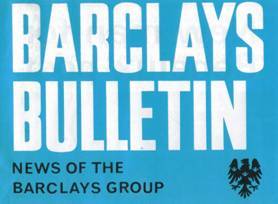
|

MARTINS Bank is now a wholly-owned subsidiary of Barclays Bank
and new Barclays' ’hares and Loan Stock have been allotted to the former
shareholders of Martins under the terms of the Scheme of Arrangement for
the merger of the two companies. Martins will continue to trade in its own
name for the time being as a member of the Barclays Group, but in order to
obtain full benefit from the merger it is planned that the two banks should
become one by 1970.
|
WHY NOT ALSO VISIT
|
|

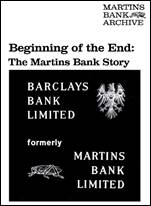
|
This will be achieved by means of a private Act of Parliament,
which it is hoped will receive Assent about the middle of next year, and
become effective on or before January 1, 1970. Meanwhile several measures are
being taken to help pave the way to complete integration. They include:
The appointment of two Directors from each bank to serve also on
the Board of the other. Mr. W. G. Bryan and Mr. A. L. Grant will serve on the
Board of Martins, and Sir Cuthbert Clegg and Mr. J. H. Keswick join the Board
of Barclays.

A Co-ordinating Team has been formed consisting of three
Barclays representatives, Mr. R. J. H. Gillman (Secretary) and Mr. K. A. Ebbs
and Mr. J. G. Quinton (Assistant General Managers), and Mr. A. K. Bromley
(Assistant General Manager of Martins).

Working parties have been set up to harmonise the systems,
procedures and stationery of the two banks, and alterations will be
introduced gradually.

Some Head Office Departments are to be brought together almost
immediately.

It is planned to conduct the executor, trustee, income tax, new
issue, registration and unit trust work of the combined banks through Martins
Bank Trust Company Ltd., which will be renamed.

Control of some
Martins branches will shortly be transferred to Barclays. A pilot scheme will
begin this month in some Barclays Districts where only a few Martins branches
are situated. It is hoped that the experience gained will enable the scheme
to be extended throughout the rest of the country during 1969.

Eventually the present
Barclays Local Head Offices, with one addition, will control all the branches
of the combined bank.

A new Local Head
Office will be established in Preston, controlling all branches in
Cumberland (with the exception of Martins, Alston), Westmorland and Lancashire
north of a line drawn south of Lytham, Leyland, Chorley, Darwen, Accrington
and Burnley, and Martins, Bentham.

The Welsh branches at present under Liverpool Local Head Office
will be transferred to the control of Shrewsbury L.H.O. The situation in
London is still being considered and there may be minor boundary changes
elsewhere, but the policy is that Martins branches will come under the Local
Head Office in whose District they are situated.
Chairman's Message
Mr. John Thomson,
Chairman of Barclays Bank Limited, stresses that the objective is the
creation of a single, integrated organisation with equal opportunities for
all. Mr. Thomson writes: “The merger of Martins with Barclays is an event of
great significance in our histories and I extend a warm welcome to Martins
Bank and every member of its staff on behalf of the Barclays Group. At the
same time I would like to try and answer some of the questions which must be
uppermost in your minds. This has been the ‘year of the merger’ for British
industry, and our own merger is part of the general drive for increased
efficiency through the creation of larger, more economic units. At the same
time we are, in order to reap the full benefits of the merger, taking a fresh
look at our organisational structure.

“Some training in
different systems and routines will be necessary, but I am confident that
this will not present a serious problem and that we can move smoothly towards
integrated systems common to all staff. 'Obviously some of you will be
wondering whether you will have to move as a result of the merger. So far as
branch staff are concerned, there will be little or no change in the existing
standards of mobility. In other cases moves will be kept to a minimum, and
adequate notice will be given to those concerned. Finally, a word about
promotion prospects. No member of the staff of either bank need feel that his
or her abilities will be neglected. The two Staff Departments are now working
in close liaison in order to ensure that the staff of both banks are
henceforth treated as one for the purpose of promotion. There will therefore
be equal opportunities for all, with a unified structure for recruitment and
training. A merger inevitably means change -but there can be no progress
without it. Fortunately both Barclays and Martins have similar traditions,
structures and philosophies and I am confident that with patience, understanding
and co-operation, the adjustments can be achieved smoothly and painlessly”.

June 1969 - On the books at last…

|

|
In
Barclays’ half year accounts for 1969, its subsidiaries, including Martins
are listed under assets. Martins is worth a cool £56.5million, more than
fifteen times the value of The British Linen Bank, and more than twice that
of Barclays’ successful Dominion and Colonial arm. Acquiring Martins
strengthens Barclays’ position in England and Wales, control of the British
Linen Bank gives Barclays a good foothold in Scotland. Barclays also has
ties with The Bank of Scotland and the Royal Bank of Scotland (formerly
Williams and Glyn’s Bank) which will last well into the 1980s.


|
|
1969 – Spread Eagle - End of the beginning?
Just as Martins Bank Magazine itself caters for
the staff of LEWIS’S BANK, following Martins’ acquisition of their
branches, Barclays’
‘Spread Eagle’ magazine must now begin to welcome colleagues from Martins.
The difference of course, is that Lewis’s Bank, whilst under the ownership
of Martins always kept its name and style of operations. It is no
exaggeration to state that Martins Bank Magazine has been cherished by uge
numbers of the Staff of martins Bank. Born out of the Wartime Lifeline
Newsletters, nothing shows better the true family spitir of the Bank.
Spread Eagle is a similar publication to Martins Bank Magazine, in that it
too makes the most of everyday stories about the staff of the Bank, and
keeps everyone informed as the world of banking changes. Sport, amateur
dramatics, fashion, the usual stuff… The Staff of Martins are introduced to
Spread Eagle in a feature in the final full edition of their own Magazine
in the Autumn of 1969. By this time, much of Martins has been absorbed into
Barclays, all that remains is for the 700+ Branches and Subbranches of the
Bank to be officially handed over on the Appointed Date, 15 December 1969.
As the merger itself progresses, Barclays prints what is meant to be a
reassuring customer leaflet, the slightly patronising text proclaiming that
the situation is in fact simply nothing worse than “the end of the
beginning”. What is abundantly obvious from the leaflet, as shown below, is
that against the wishes of Martins’ Staff and customers, the name of the
new bank will be Barclays and ONLY Barclays, and this is therefore,
the beginning of the end…
|

|
|

|
Barclays /
Martins merger
Martins Bank joined up with Barclays last
November. Since then we've been getting on with the business of
integrating. A special Act of Parliament has been passed to simplify many
of the details involved You'll start noticing the differences around Christmas.
Martins will begin to call itself Barclays. Martins customers will become
customers of Barclays. Barclays name will start replacing Martins on
branches and cheque books. These are the unmistakable signs that the two
great banks with their traditions of progressive thinking and personal
service, are getting together to strengthen
even further Barclays’ position as one of the world's leading banking
groups with over 5000 branches in 50 countries. Yet December marks only the end of the beginning, the technicalities of the merger. With
these out of the way. the enlarged Barclays can begin to make full use of
the benefits of amalgamation. Bigger resources and wider facilities will
allow us to provide a service to meet every foreseeable future need -
whether it's for a multi-million-pound public company or a small private
business, a surtax paying executive or a school leaver in his first Job There’s a Barclays branch near you - though it may
still be called Martins. But whatever the name over the door, you’ll find
the same service (and welcome) inside. Why not call in and see for yourself
exactly what we’re so enthusiastic about?
|
|
|
|
|

BARCLAYS BANK MARTINS BANK

June
1969 - Game, set, and match.
Amongst the treasures inherited by Barclays, is
the sub branch on the Centre Court at the All-England Tennis Club, Wimbledon,
SW19. Martins advertises this special service in the official Wimbledon
souvenir programme each year. The following examples show the change from
1961 to 1969 when the merger becomes part of the message…

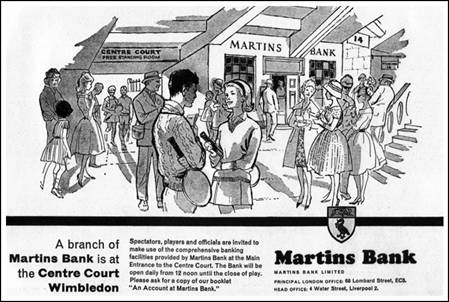 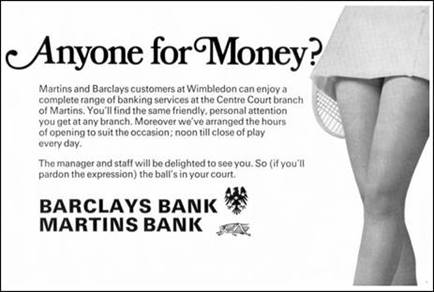

December
1969 - It’s a sign of the times…
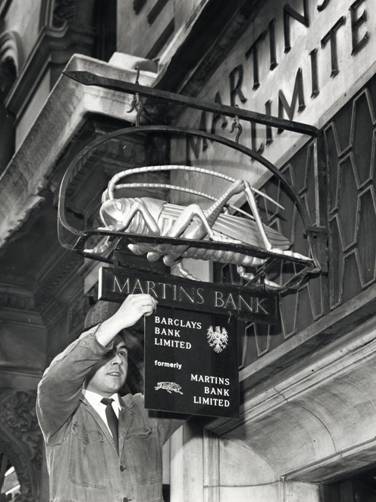 The signs they are a changing, in what
becomes a familiar ritual up and down the land, as the Eagle takes over from
the Grasshopper – “Barclays Bank Limited, formerly Martins Bank Limited”
signs are displayed in over seven hundred locations to announce the demise of
Martins. Our picture shows the sign being hung outside our London Chief
Overseas Branch, at 80 Gracechurch Street. The signs they are a changing, in what
becomes a familiar ritual up and down the land, as the Eagle takes over from
the Grasshopper – “Barclays Bank Limited, formerly Martins Bank Limited”
signs are displayed in over seven hundred locations to announce the demise of
Martins. Our picture shows the sign being hung outside our London Chief
Overseas Branch, at 80 Gracechurch Street.
Martins’ glory days are fantastic. From making the
outrageously bold statement of building a palatial head office completely
away from London in the 1930s, to opening dozens of modern new branches
finished to exacting standards and built from the most expensive materials in
the 1960s, Martins has made a big splash in the ocean of banking, and all
this in the days when banks, in return for responsible lending and financial
management, are rewarded with the trust and loyalty of their customers.
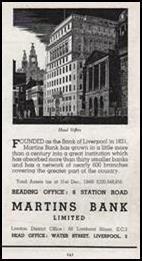 A reputation for friendly, high
quality service has attracted wealthy and/or loyal customers to the Bank from
the ranks of young AND old, thanks to Martins’ constant quest to be modern
whilst still managing to retain some traditional values. It comes as no
surprise then, that this collection of banks, built up over 400 years is a
highly desirable target for takeover or merger, and Barclays’ overtures to
Martins lead to the full marriage of the two banks at the end of 1969. The changeover will need to be
handled as sensitively as possible, for Martins Bank is loved both by its
customers and staff, many of whom are vehemently opposed to their bank
jumping into bed with a rival. A reputation for friendly, high
quality service has attracted wealthy and/or loyal customers to the Bank from
the ranks of young AND old, thanks to Martins’ constant quest to be modern
whilst still managing to retain some traditional values. It comes as no
surprise then, that this collection of banks, built up over 400 years is a
highly desirable target for takeover or merger, and Barclays’ overtures to
Martins lead to the full marriage of the two banks at the end of 1969. The changeover will need to be
handled as sensitively as possible, for Martins Bank is loved both by its
customers and staff, many of whom are vehemently opposed to their bank
jumping into bed with a rival.
This has been a time when Martins has opened many
new branches, and shown that it is in touch – not only with the youth of the
day, but also with individual areas of the country and their banking needs.
Its regional structure, based on local decision making and Managers who know
their towns, villages and people inside out, are what we are crying out for
in the twenty-first century.
 
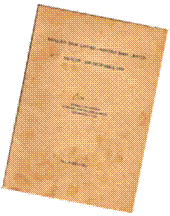 It’s not ALL doom and
gloom… It’s not ALL doom and
gloom…

Despite the views of many that the merger is
nothing more than a takeover, Martins does actually have some influence over
the future of the combined business. In total Barclays will acquire just shy
of 700 Branches and sub Branches. The business of Martins Bank Trust Company
Limited is also a highly desirable prize, and it remains the view of many who
worked for the Company, that it was Martins who effectively took over
Barclays’ interests in the same field. Looking at the overall network of
Branches and Departments, and in the North of England in particular, Barclays
will gain dozens of Branches that are newer, larger or better placed than
existing Barclays offices. A number of Barclays outlets will actually close
in favour of their Martins counterpart being used. These are identified in a
Merger Report issued on 15 December 1969 – the date by which the two Banks’
businesses must by law be brought fully together. We list here the details
from that report, of the Barclays Branches that had to fall on their sword,
either by closing altogether or by being downgraded to sub-Branch status…

|
BARCLAYS
BRANCHES CLOSED
Bristol Broadmead
Cockermouth
Consett
Darwen
Gateshead
Guisborough
Keynsham
Kirkby Stephen
|
Leicester Charles Street
London Fenchurch Street Station
Monkwearmouth
Moreton
Ramsey Isle of Man
Skelmersdale
Swanley
Ulverston
Urmston
|
Wallasey New Brighton
West Kirby
Widnes Victoria Road
BARCLAYS BRANCHES DOWNGRADED
Hebburn
Newcastle upon Tyne Jesmond Road
Sale
Wallsend
Whitefield
|

A good innings for Old trafford?

|
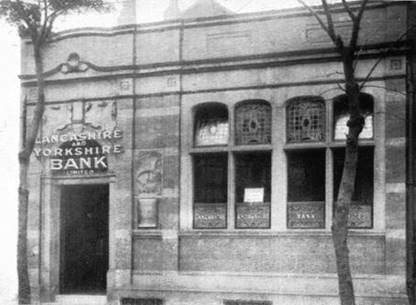
1
|
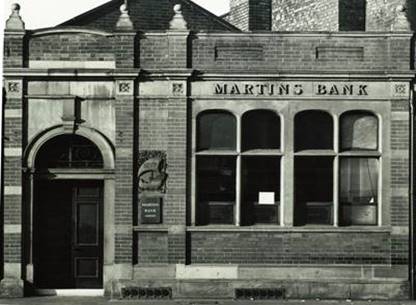
2

|
|
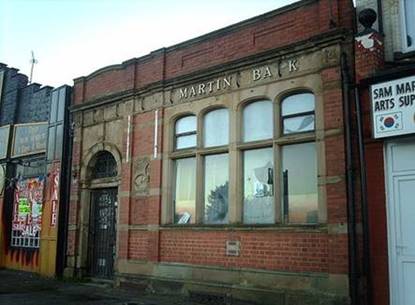
3
|
1.
Proud and beautifully appointed: The Lancashire
and Yorkshire Bank Branch at old Trafford, seen here in 1922, with six
years still to go before it merges with Martins.
2.
In the 1960s we can only guess which famous
sporting types might have been popping in to cash a cheque before taking
part in a cricket or football match.
3.
Finally, in 2006 the same branch is seen empty
and frozen in time. A reminder of better times, when famous sporting types
popped in to Old Trafford to cash a cheque.
|

1970 to 1982 - Memorabilia…
|
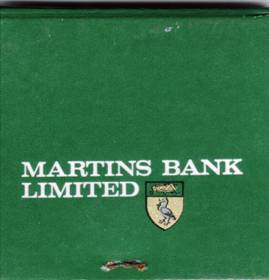
|
Martins green is
replaced by Barclays blue in what is almost the last giveaway to feature
the Martins grasshopper. The Barclaytrust matchbook is given away to
customers of Barclays Bank Trust Company, which can now boast the
expertise, products and profitability of Martins Bank’s Trustee and Income
Tax offices and Martins Unicorn, the jewel in the crown of our Bank’s
services to investors. This piece of treasure will pay the bills at
Barclays for decades to come, and undergo several revamps and name changes
before becoming the Barclays Wealth we know today…
|
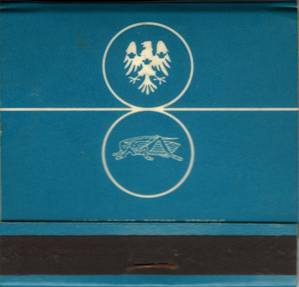
|
  The symbol of the grasshopper,
dating back to the time of Thomas Gresham in 1563 will appear on the Barclays
cheques and statements of Martins customers as a kind of ‘heritage reminder’,
and will remain on some Barclays
stationery until 1982. The Liver Bird, will not however be seen again, even
though she still symbolises the Bank that dared to be different. The images
on these playing cards could well be the final assertion of the dominence of
the Spread Eagle over the Grasshopper, as another of Trust Company’s
giveaways is a small velvety box containing two packs. No longer afforded the
protection of the majestic and mysterious Liver Bird, our Grasshopper must
now roll over and accept defeat. The symbol of the grasshopper,
dating back to the time of Thomas Gresham in 1563 will appear on the Barclays
cheques and statements of Martins customers as a kind of ‘heritage reminder’,
and will remain on some Barclays
stationery until 1982. The Liver Bird, will not however be seen again, even
though she still symbolises the Bank that dared to be different. The images
on these playing cards could well be the final assertion of the dominence of
the Spread Eagle over the Grasshopper, as another of Trust Company’s
giveaways is a small velvety box containing two packs. No longer afforded the
protection of the majestic and mysterious Liver Bird, our Grasshopper must
now roll over and accept defeat.
 
All
good things must come to an end…

|
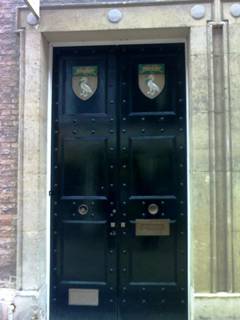

The doorway at
King’s Lynn is slightly recessed. Consequently
the doors have
remained
sheltered from
the elements.
|
The doors might be shut
forever, but the once mighty prescence of Martins is still felt all over
England and Wales. At 103a High street KING’S LYNN, (2008 left)
the Martins building was a chic fashion outlet. Ironically, having closed
its branch there, Barclays went on to swallow up The Woolwich and acquired
premises only four doors down at No 107!
At Barclays the Headrow, Leeds
(2007),and Heaton Chapel (2000) below, the unmistakable coat of arms
reminds everyone that this too is the home of the bank that went to extremes
to be helpful…
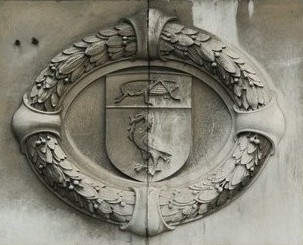 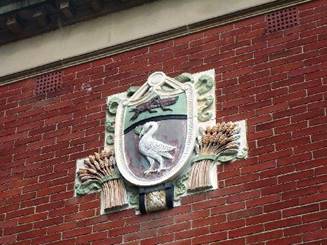

Pictures © : www.yorkshiredailyphoto.com and Michael
Alderson
|

Farewell
to Martins Bank Magazine…
The final edition of Martins Bank Magazine is the
Winter 1969 commemorative issue, which looks back at hightlights of the
twenty four years – and therefore 96 issues – of the magazine’s existence.
The fawewell issue begins with this letter from Martins’ Chief General
Manager…

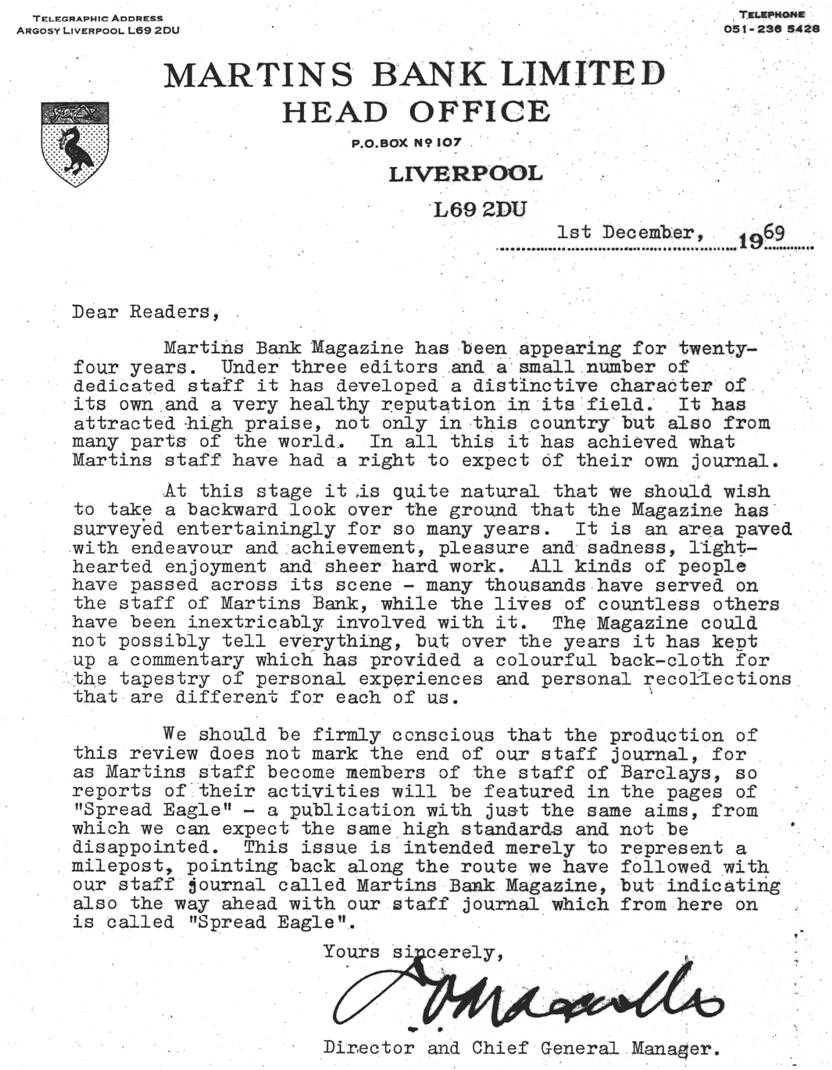

The song has ended, but
the melody lingers on…



The important of Martins Bank’s Operatic and
Dramatic Society, and its various regional offshoots, is recognised by
Barclays, and under the auspices of Barclays Bank Society of the Arts,
“Martins Operatic Society” ( minus the word “BANK”) continues to stage lavish
and sophisticated productions beyond the merger, until its own eventual
demise in 1980. You can read muchmore about this in our SONG AND DANCE feature.

Goodbye everybody…
x
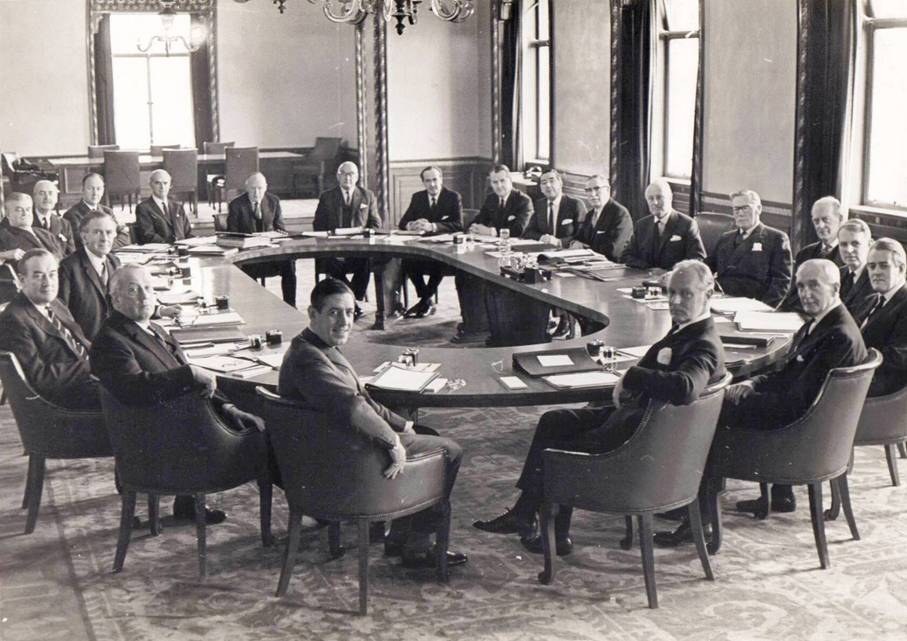
BOARDROOM BLUES
The last ever
meeting of Martins Board, 9 December 1969…

 M M

|

![]()
![]()
















































